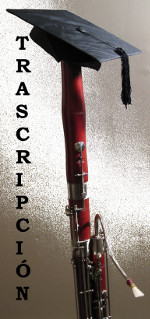Weissenborn Opus 8/2, Study
#49 for advanced bassoon students. Fingerings for Eb5.
Adjustments to the reed for high register playing on the bassoon. Guest
performer Collin Walter. Copyright © 2014-2020 by Terry B. Ewell. All Rights Reserved.
Practicando el estudio de Weissenborn Nº49. Weissenborn Opus
8/2, estudio Nº49 para estudiantes avanzados de fagot.
Digitaciones para Mib5. Ajustes a la caña para tocar en el
registro agudo del fagot. Intérprete invitado, Collin Wanter.
Por Terry B. Ewell, Profesor Digital de Fagot. Traducido y doblado por
Elena Iakovleva y Carlos Gabriel Arias Sánchez. BDP#157.
www.2reed.net.
TUTORIAL
1. Welcome, this is Terry Ewell. Weissenborn Study #49 expands
the range of the instrument to Eb5. This note, however, is a
problematic pitch on the German system bassoon. It does not articulate
well or respond well to large slurs.
1. Bienvenidos, éste es Terry Ewell. El estudio de
Weissenborn Nº49 expande el rango del instrumento hasta el Mib5.
Esta nota, sin embargo, es una frecuencia problemática en el
sistema alemán de fagot. Es difícil de articular y no
responde bien en ligaduras largas.

2. Let me leave you with several fingering possibilities for Eb5.
Please be aware that none of them will perform as satisfactorily as
fingerings for D5.
2. Déjeme ofrecerles varias posibilidades de
digitación para el Mib5. Por favor tenga en cuenta que ninguna
de ellas va a ser tan satisfactoria como las digitaciones para el
Re5.


3. You might find it helpful to look at the other suggestions
listed in the Bassoon-Family Fingering Companion.
3. Tal vez le resulte útil ver las otras sugerencias listadas
en el catálogo de digitaciones “Basoon-Family Fingering
Companion”.
http://www.idrs.org/resources/BSNFING/FINGHOME.HTM
4. Here are fingerings for the trills presented in the study:
4. Aquí hay algunas digitaciones para los trinos presentados en el estudio:

5. I perform the mordents in line 5 with these fingerings:
5. Yo toco los mordentes en el quinto renglón, con estas digitaciones:

REFLECTION Reflexión
6. Most performers find it helpful to use a reed adjusted for the
high register to effectively perform this and the next study. My videos
on reed finishing (BDP# 86-91) present my concepts and suggestions for
adjusting bassoon reeds. I encourage you to study them carefully and
the companion article “A Pedagogy for Finishing Reeds for the
German-System (Heckel-System) Bassoon.” A link to
the revised paper is available here:
http://www.2reed.net/EwellArticles/ReedAdjustingNew.pdf
Full reference: “A Pedagogy for Finishing Reeds for
the German-System (Heckel-System) Bassoon,”
The
Double Reed 23/3 (2000): 99-108.
6. A la mayoría de los intérpretes les resulta
útil usar una caña ajustada para el registro agudo, para
tocar efectivamente éste y el siguiente estudio. Mis videos
sobre la terminación de las cañas (BDP# 86-91) presentan
mis conceptos y sugerencias para ajustar las cañas de fagot. Lo
aliento a estudiarlos con detenimiento, así como su
artículo acompañante “Pedagogía para
terminar cañas del fagot de sistema alemán (sistema
Heckel)”. Aquí hay un enlace a la monografía
revisada:
“Una pedagogía para el
acabado de cañas de fagot de Sistema alemán (Sistema
Heckel),” Primera Parte, Revista AFOES no.6 (2017): 34-40. This
is a translation of an updated version of “A Pedagogy for
Finishing Reeds for the German-System (Heckel-System) Bassoon,”
The Double Reed 23/3 (2000): 99-108.
“Una pedagogía para el
acabado de cañas de fagot de Sistema alemán (Sistema
Heckel),” Secunda Parte, Revista AFOES no.7 (2018): 56-60. This
is a translation of the second part of an updated version of “A
Pedagogy for Finishing Reeds for the German-System (Heckel-System)
Bassoon,” The Double Reed 23/3 (2000): 99-108.
7. Smaller reeds favor higher pitches. This is why an oboe reed
is smaller than a bassoon reed, for instance. Creating a smaller
bassoon reed will aid the higher notes. You can shorten the blade by
cutting the tip.
7. Las cañas más pequeñas favorecen los
registros más agudos. Por esto es que una caña de oboe es
más pequeña que una de fagot, por ejemplo. Hacer
cañas de fagot más pequeñas ayudará para
tocar las notas más altas. Usted puede acortar hoja
cortándole la punta.
8. The poor man’s way to cut the tip is to use
scissors. The traditional way to cut the tip is to use a knife and
cutting block. Use a different knife than the one you use for scraping,
because cutting the reed tip will dull the knife.
8. El método improvisado es cortar la punta con una tijera.
La forma tradicional para cortar la punta es usando un cuchillo y una
tabla. Use un cuchillo diferente del que usa para raspar, ya que
podría desafilarse.
9. You could also narrow the blade.
9. También podría angostar la hoja.
10. Also a narrow throat helps the high register.
10. Además, un cuello más angosto ayuda en el registro agudo.
11. In addition, rounding the first and second wires provides more
tension in the blade and aids with the higher harmonics and the higher
notes on the instrument.
11. Adicionalmente, redondear el primer y segundo alambre provee
más tensión a la hoja y ayuda a los armónicos
más altos y las notas más agudas del instrumento.
12. A high note reed also features a greater heart to wings ratio
and a greater spine to rail ratio. Concepts of these ratios are
detailed in my paper.
12. Una caña para notas agudas tiene una mayor
proporción corazón/alas y una mayor proporción de
la columna con respecto a los rieles. Los conceptos detallados de estas
proporciones están en mi monografía.
13. Depending on the style of your normal bassoon reed, you may
not need to make all of the adjustments given above. Just two
adjustments may be all that is required for you.
13. Dependiendo del estilo de su caña de fagot habitual, tal
vez no necesite hacer todos los ajustes mencionados. Tan sólo
dos de ellos puede ser todo lo que le haga falta.





